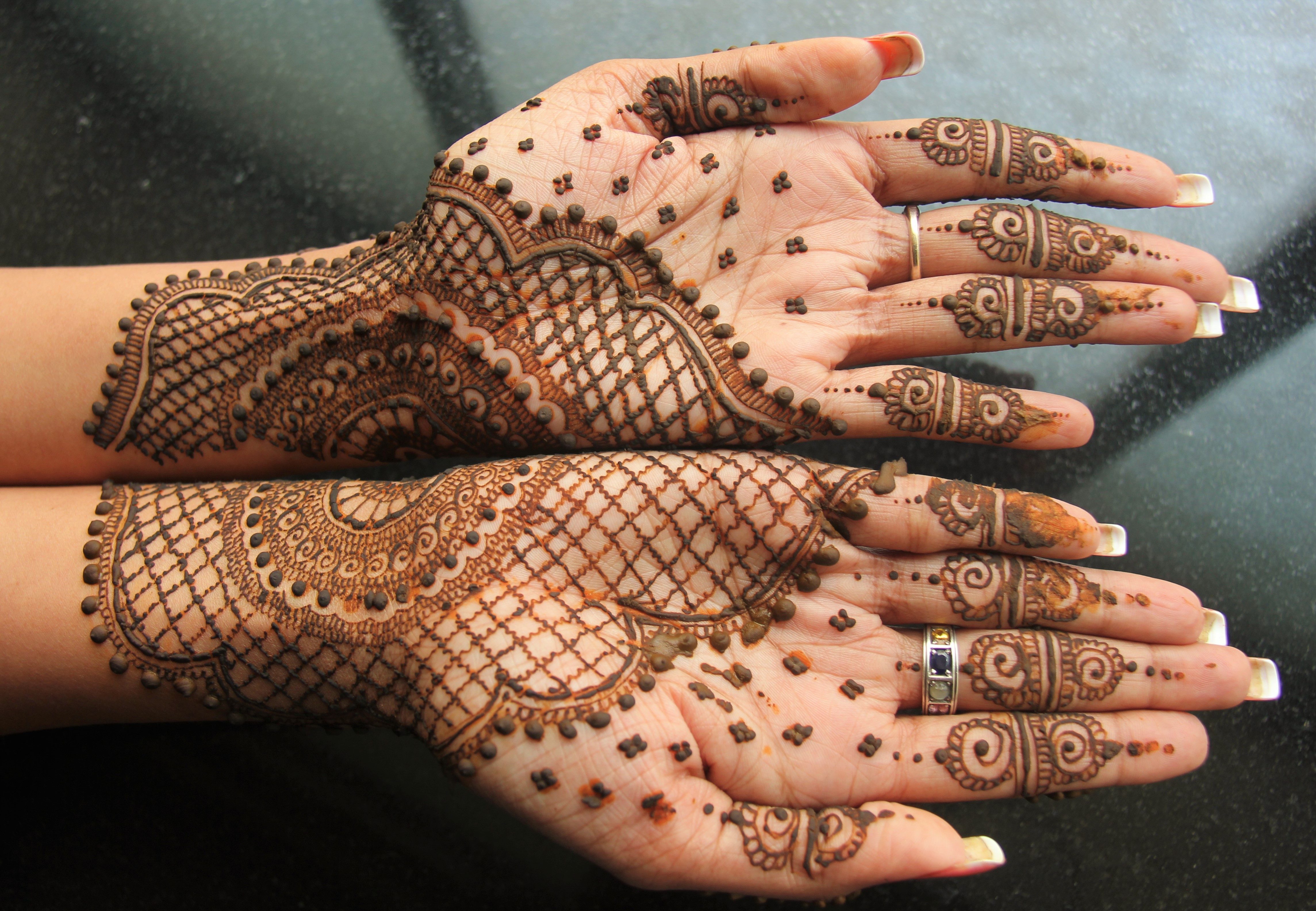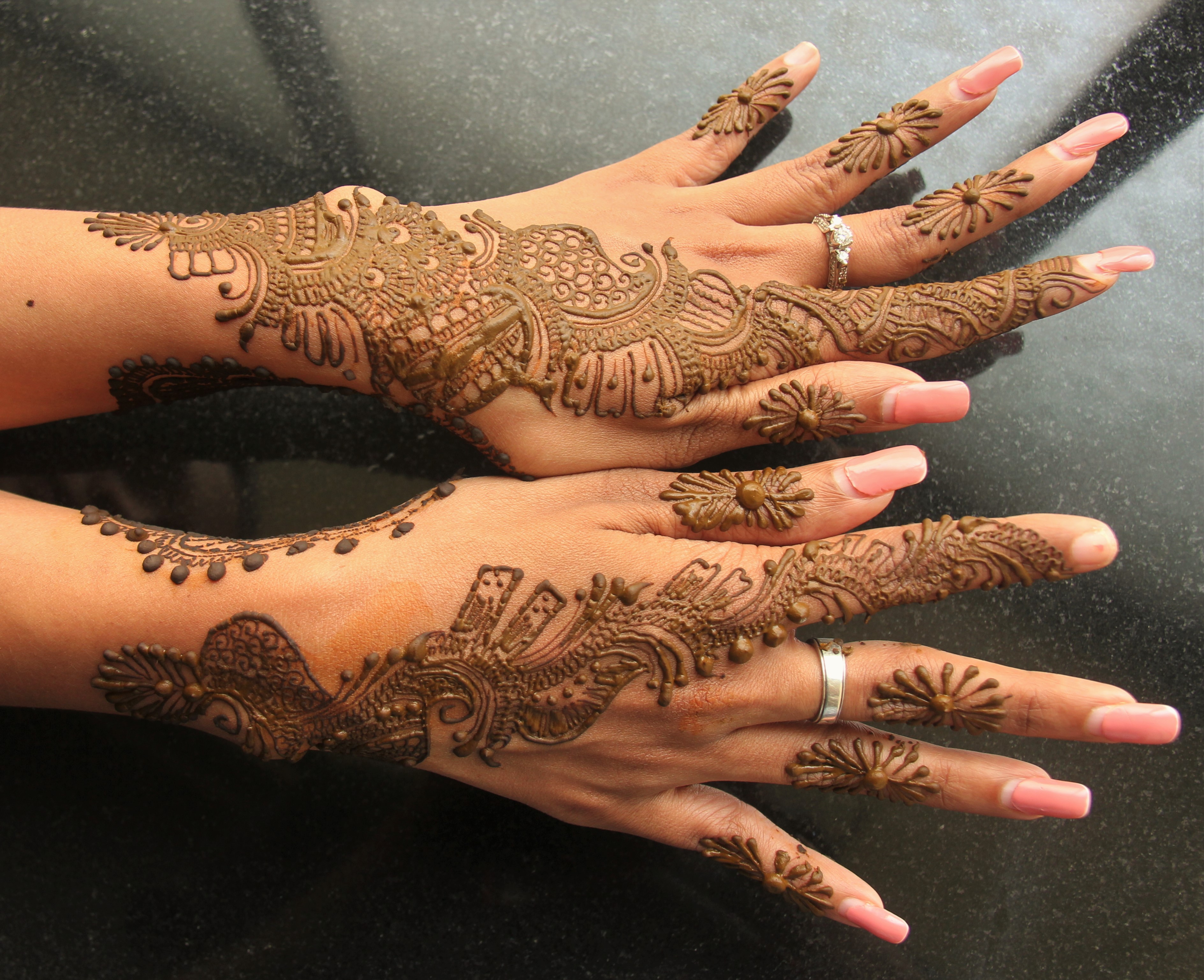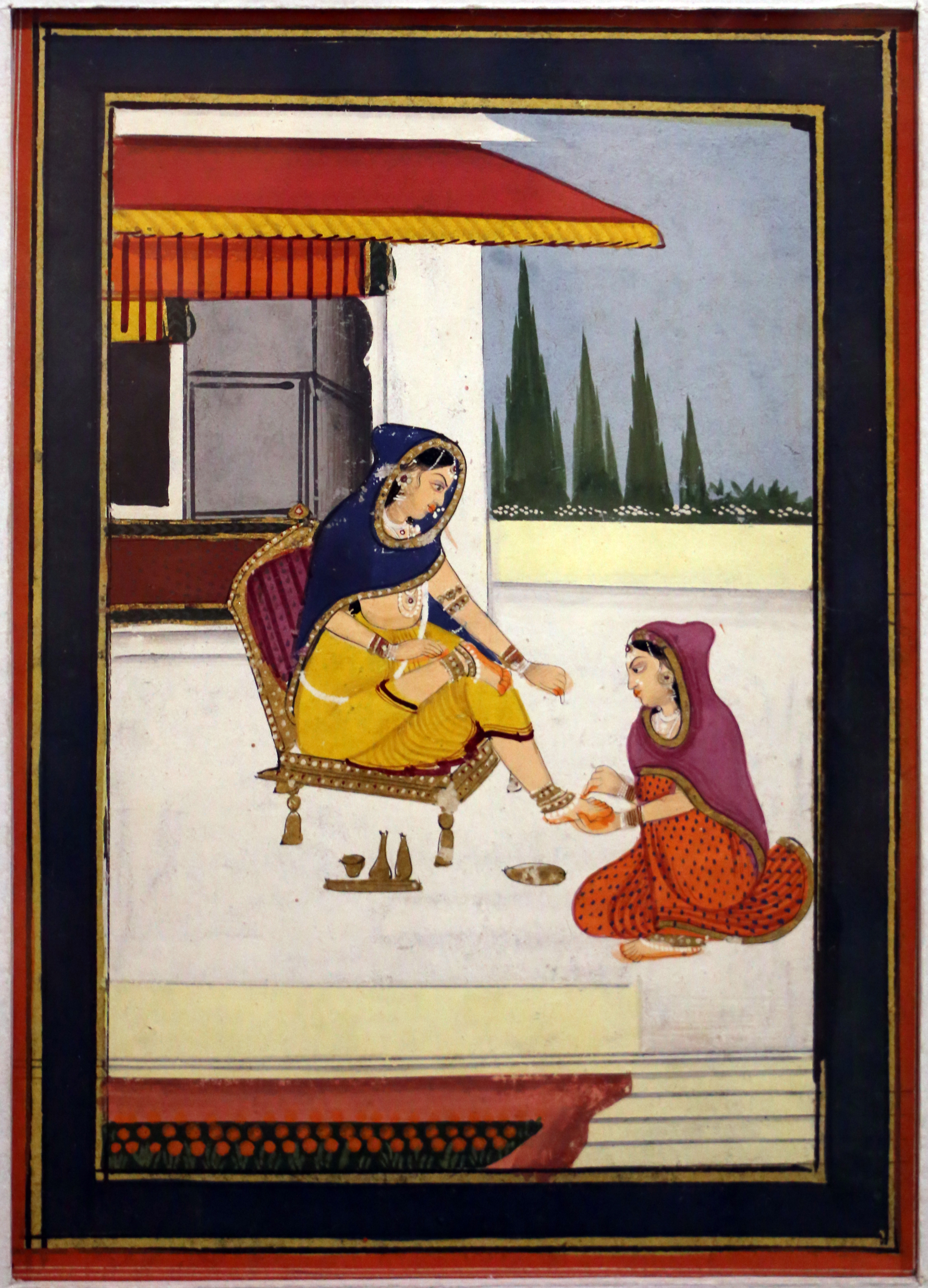Mehndi on:
[Wikipedia]
[Google]
[Amazon]

 Mehndi () is a form of
Mehndi () is a form of

 Mehndi is a ceremonial art form common in India, Pakistan, Bangladesh, and occasionally Afghanistan. It is typically applied during weddings - for Sikh, Muslim and Hindu brides. In
Mehndi is a ceremonial art form common in India, Pakistan, Bangladesh, and occasionally Afghanistan. It is typically applied during weddings - for Sikh, Muslim and Hindu brides. In
Once this is done, fruits, nuts, and pastries would be brought out and songs would be sung in hopes of making the bride cry. This was done because it was thought that the bride's crying would bring good luck. The bride would then sit on a cushion while her mother-in-law placed a gold coin in her hand as another sign of good luck. Once the bride was given the gold coin, the henna would be applied. The person who applied the henna was always someone who was already known to be happily married; that person would apply the henna onto the bride's palms, fingers, and toes. The henna was made from dried henna leaves, and the process of application took a long time. For this reason, it was suggested that it be applied between thirty-two and forty-eight hours before the wedding so that it may have enough time to stain the skin. In addition to the bride, most women at the mehndi ceremony also apply the henna to their hands for aesthetics.

body art
Body art is art made on, with, or consisting of, the human body. Body art covers a wide spectrum including tattoos, body piercings, scarification, and body painting. Body art may include performance art, body art is likewise utilized for investi ...
and temporary skin decoration from the Indian subcontinent
The Indian subcontinent is a physiographical region in Southern Asia. It is situated on the Indian Plate, projecting southwards into the Indian Ocean from the Himalayas. Geopolitically, it includes the countries of Bangladesh, Bhutan, In ...
usually drawn on hands or legs. They are decorative designs that are created on a person's body, using a paste, created from the powdered dry leaves of the henna
Henna is a dye prepared from the plant ''Lawsonia inermis'', also known as the henna tree, the mignonette tree, and the Egyptian privet, the sole species of the genus ''Lawsonia''.
''Henna'' can also refer to the temporary body art resulting fr ...
plant ('' Lawsonia inermis''). It is a popular form of body art in South Asia
South Asia is the southern subregion of Asia, which is defined in both geographical and ethno-cultural terms. The region consists of the countries of Afghanistan, Bangladesh, Bhutan, India, Maldives, Nepal, Pakistan, and Sri Lanka.;;;;; ...
including countries such as India
India, officially the Republic of India (Hindi: ), is a country in South Asia. It is the List of countries and dependencies by area, seventh-largest country by area, the List of countries and dependencies by population, second-most populous ...
, Bangladesh
Bangladesh (}, ), officially the People's Republic of Bangladesh, is a country in South Asia. It is the eighth-most populous country in the world, with a population exceeding 165 million people in an area of . Bangladesh is among the mo ...
, Pakistan
Pakistan ( ur, ), officially the Islamic Republic of Pakistan ( ur, , label=none), is a country in South Asia. It is the world's List of countries and dependencies by population, fifth-most populous country, with a population of almost 24 ...
, Maldives
Maldives (, ; dv, ދިވެހިރާއްޖެ, translit=Dhivehi Raajje, ), officially the Republic of Maldives ( dv, ދިވެހިރާއްޖޭގެ ޖުމްހޫރިއްޔާ, translit=Dhivehi Raajjeyge Jumhooriyyaa, label=none, ), is an archipelag ...
, Sri Lanka
Sri Lanka (, ; si, ශ්රී ලංකා, Śrī Laṅkā, translit-std=ISO (); ta, இலங்கை, Ilaṅkai, translit-std=ISO ()), formerly known as Ceylon and officially the Democratic Socialist Republic of Sri Lanka, is an ...
, Nepal
Nepal (; ne, नेपाल ), formerly the Federal Democratic Republic of Nepal ( ne,
सङ्घीय लोकतान्त्रिक गणतन्त्र नेपाल ), is a landlocked country in South Asia. It is ma ...
and resembles similar traditions of henna as body art found in North Africa
North Africa, or Northern Africa is a region encompassing the northern portion of the African continent. There is no singularly accepted scope for the region, and it is sometimes defined as stretching from the Atlantic shores of Mauritania in ...
, East Africa
East Africa, Eastern Africa, or East of Africa, is the eastern subregion of the African continent. In the United Nations Statistics Division scheme of geographic regions, 10-11-(16*) territories make up Eastern Africa:
Due to the historica ...
and the Middle East
The Middle East ( ar, الشرق الأوسط, ISO 233: ) is a geopolitical region commonly encompassing Arabian Peninsula, Arabia (including the Arabian Peninsula and Bahrain), Anatolia, Asia Minor (Asian part of Turkey except Hatay Pro ...
. In the West, mehndi is commonly known as henna tattoo. Henna
Henna is a dye prepared from the plant ''Lawsonia inermis'', also known as the henna tree, the mignonette tree, and the Egyptian privet, the sole species of the genus ''Lawsonia''.
''Henna'' can also refer to the temporary body art resulting fr ...
has been used as a dye for the skin since ancient times.
There are many variations and designs. Women usually apply mehndi designs to their hands and feet, though some, including cancer patients and women with alopecia
Hair loss, also known as alopecia or baldness, refers to a loss of hair from part of the head or body. Typically at least the head is involved. The severity of hair loss can vary from a small area to the entire body. Inflammation or scar ...
occasionally decorate their scalps. The standard color of henna is brown, but other design colors such as white, red, black and gold are sometimes used.
''Mehndi'' in Indian tradition is typically applied during Hindu wedding
A Hindu wedding, also known as Vivaha (Devanagari: विवाह; Kannada script: ವಿವಾಹ; ''Vivaaha'') (), Lagna (लग्न), or Kalyanam (Devanagari: कल्याणम्; Kannada script: ಕಲ್ಯಾಣಮ್; ta, க� ...
s and festivals like Karva Chauth, Vat Purnima
Vat Purnima (, , also called ''Vat Savitri'' Vrat) is a Hindu celebration observed by married women in Nepal, North India and in the Western Indian states of Maharashtra, Goa, Kumaon, Gujarat. On this Purnima (full moon) during the three days of ...
, Diwali
Diwali (), Dewali, Divali, or Deepavali ( IAST: ''dīpāvalī''), also known as the Festival of Lights, related to Jain Diwali, Bandi Chhor Divas, Tihar, Swanti, Sohrai, and Bandna, is a religious celebration in Indian religions. It is ...
, Bhai Dooj
Bhai Dooj, Bhaubeej, Bhai Tika, Bhai Phonta or Bhratri Dwitiya is a festival celebrated by Hindus on the second lunar day of the Shukla Paksha (bright fortnight) of Kartika, the eighth month of the Vikram Samvat Hindu calendar or the Shalivahan ...
, Navraatri, Durga Pooja and Teej
Teej ( ne, तीज, Tīja, translit-std=ISO) is the generic name for a number of Hindu festivals that are celebrated by women and girls. and welcome the monsoon season and are celebrated primarily by girls and women, with singing, dancing, ...
. Muslims in South Asia
South Asia is the southern subregion of Asia, which is defined in both geographical and ethno-cultural terms. The region consists of the countries of Afghanistan, Bangladesh, Bhutan, India, Maldives, Nepal, Pakistan, and Sri Lanka.;;;;; ...
also apply mehndi during Muslim weddings as well as festivals such as Eid-ul-Fitr and Eid-ul-Adha.
In Hindu
Hindus (; ) are people who religiously adhere to Hinduism. Jeffery D. Long (2007), A Vision for Hinduism, IB Tauris, , pages 35–37 Historically, the term has also been used as a geographical, cultural, and later religious identifier for ...
and Sikh festivals, women often have henna applied to their hands, feet and sometimes the backs of their shoulders. Conversely, men usually have it applied on their arms, legs, back, and chest. For women, it is usually drawn on their palms, backs of their hands and on feet, where the design will be clearest due to contrast with the lighter skin on these surfaces, which naturally contains less of the pigment melanin
Melanin (; from el, μέλας, melas, black, dark) is a broad term for a group of natural pigments found in most organisms. Eumelanin is produced through a multistage chemical process known as melanogenesis, where the oxidation of the amino ...
.
Likely due to the desire for a "tattoo-black" appearance, some people add the synthetic dye
A dye is a colored substance that chemically bonds to the substrate to which it is being applied. This distinguishes dyes from pigments which do not chemically bind to the material they color. Dye is generally applied in an aqueous solution and ...
p-Phenylenediamine
''p''-Phenylenediamine (PPD) is an organic compound with the formula C6H4(NH2)2. This derivative of aniline is a white solid, but samples can darken due to air oxidation. It is mainly used as a component of engineering polymers and composites lik ...
(PPD) to henna to give it a black colour. PPD may cause moderate to severe allergic reactions when applied to skin.
Etymology
The origin of "mehndi" is from the Sanskrit word "mendhika," which refers to a plant that releases a red dye. According to ''A Dictionary of Urdu, Classical Hindi and English'' Mehndi also refers to "the marriage-feast on the occasion of the bride's hands and feet being stained with henna."Origins
The use of mehndi has its origins in the ancientMiddle East
The Middle East ( ar, الشرق الأوسط, ISO 233: ) is a geopolitical region commonly encompassing Arabian Peninsula, Arabia (including the Arabian Peninsula and Bahrain), Anatolia, Asia Minor (Asian part of Turkey except Hatay Pro ...
and Indian Subcontinent where it was used in civilizations such as Babylon
''Bābili(m)''
* sux, 𒆍𒀭𒊏𒆠
* arc, 𐡁𐡁𐡋 ''Bāḇel''
* syc, ܒܒܠ ''Bāḇel''
* grc-gre, Βαβυλών ''Babylṓn''
* he, בָּבֶל ''Bāvel''
* peo, 𐎲𐎠𐎲𐎡𐎽𐎢 ''Bābiru''
* elx, 𒀸𒁀𒉿𒇷 ''Babi ...
and Ancient Egypt. It was prevalent in fourth century in India, which is evident from cave art in the Deccan
The large Deccan Plateau in southern India is located between the Western Ghats and the Eastern Ghats, and is loosely defined as the peninsular region between these ranges that is south of the Narmada river. To the north, it is bounded by the ...
, specifically in the Ajanta Caves
The Ajanta Caves are approximately thirty rock-cut Buddhist cave monuments dating from the second century BCE to about 480 CE in the Aurangabad district of Maharashtra state in India. The caves include paintings and rock-cut sculptures de ...
.
Tradition

 Mehndi is a ceremonial art form common in India, Pakistan, Bangladesh, and occasionally Afghanistan. It is typically applied during weddings - for Sikh, Muslim and Hindu brides. In
Mehndi is a ceremonial art form common in India, Pakistan, Bangladesh, and occasionally Afghanistan. It is typically applied during weddings - for Sikh, Muslim and Hindu brides. In Rajasthan
Rajasthan (; lit. 'Land of Kings') is a state in northern India. It covers or 10.4 per cent of India's total geographical area. It is the largest Indian state by area and the seventh largest by population. It is on India's northwestern ...
, the grooms are given designs that are often as elaborate as those for brides. In Assam
Assam (; ) is a state in northeastern India, south of the eastern Himalayas along the Brahmaputra and Barak River valleys. Assam covers an area of . The state is bordered by Bhutan and Arunachal Pradesh to the north; Nagaland and Manipur ...
, apart from marriage, it is broadly used by unmarried women during Rongali bihu
Bohag Bihu or Rongali Bihu ( as, ব’হাগ বিহু বা ৰঙালী বিহু) also called ''Xaat Bihu'' ( as, সাত বিহু) (seven Bihus) is a traditional ethnic festival celebrated in the Northeastern Indian sta ...
.
Process
Mehndi paste is usually applied to the skin using a plastic cone, a paintbrush or a stick. After about 15–20 minutes, the mud will dry and begin to crack, and during this time, a mixture of lemon juice and white sugar can be applied over the henna design to remoisten the henna mud so that the henna will stain darker. The painted area is then wrapped with tissue, plastic, or medical tape to lock in body heat, creating a more intense colour on the skin. The wrap (not a traditional method), is worn for two to six hours, or sometimes overnight, and then removed. When first removed, the henna design is pale to dark orange in colour and gradually darkens through oxidation, over the course of 24 to 72 hours. The final color is reddish brown and can last anywhere from one to three weeks depending on the quality and type of henna paste applied, as well as where it was applied on the body (thicker skin stains darker and longer than thin skin). Moisturizing with natural oils, such as olive, sesame seed, or coconut, will also help extend the lifetime of the stain. Skin exfoliation, salt water and chlorine in swimming pools can cause the henna tattoo to fade.In weddings
Example of a wedding tradition
The mehndi, a dye produced from a mehndi plant, would be delivered by the groom's relatives on a silver tray containing two burning candles. Before the application of the henna, the guests would throw coins over the bride's head as a symbol of fertility. Then, the bride's soon to be mother-in-law would then bring out a piece of silk cloth as a gift to the bride. The bride would then walk along the unrolled piece of silk cloth in the direction of her future mother-in-law and kiss her hand.Once this is done, fruits, nuts, and pastries would be brought out and songs would be sung in hopes of making the bride cry. This was done because it was thought that the bride's crying would bring good luck. The bride would then sit on a cushion while her mother-in-law placed a gold coin in her hand as another sign of good luck. Once the bride was given the gold coin, the henna would be applied. The person who applied the henna was always someone who was already known to be happily married; that person would apply the henna onto the bride's palms, fingers, and toes. The henna was made from dried henna leaves, and the process of application took a long time. For this reason, it was suggested that it be applied between thirty-two and forty-eight hours before the wedding so that it may have enough time to stain the skin. In addition to the bride, most women at the mehndi ceremony also apply the henna to their hands for aesthetics.
Popular mehndi patterns

Arabic mehndi designs
This pattern is drawn on the palm. Generally it starts from one corner of the wrist and ends at finger tip on the opposite corner. Vine, lace, flowers are the main elements of this pattern.Mandala mehndi designs
Mandala
A mandala ( sa, मण्डल, maṇḍala, circle, ) is a geometric configuration of symbols. In various spiritual traditions, mandalas may be employed for focusing attention of practitioners and adepts, as a spiritual guidance tool, for e ...
is a geometric configuration of symbols used in various spiritual traditions including Hinduism, Buddhism, Jainism and Shinto. Various configurations of Mandala are drawn on the center of palm in this mehndi pattern.
See also
*Henna
Henna is a dye prepared from the plant ''Lawsonia inermis'', also known as the henna tree, the mignonette tree, and the Egyptian privet, the sole species of the genus ''Lawsonia''.
''Henna'' can also refer to the temporary body art resulting fr ...
* Alta
* Body painting
Body painting is a form of body art where artwork is painted directly onto the human skin. Unlike tattoos and other forms of body art, body painting is temporary, lasting several hours or sometimes up to a few weeks (in the case of mehndi or " ...
* Temporary tattoo
A tattoo is a form of body modification made by inserting tattoo ink, dyes, and/or pigments, either indelible or temporary, into the dermis layer of the skin to form a design. Tattoo artists create these designs using several tattooing pr ...
References
{{Authority control Body art Hindu wedding rituals South Asian culture Indian wedding Pakistani wedding Nepalese art Articles containing video clips Marriage in Nepal